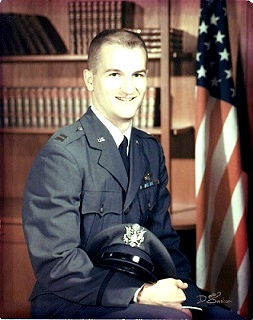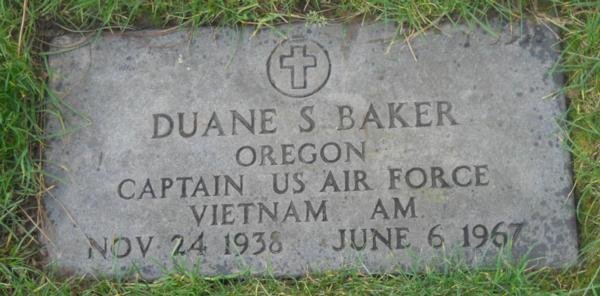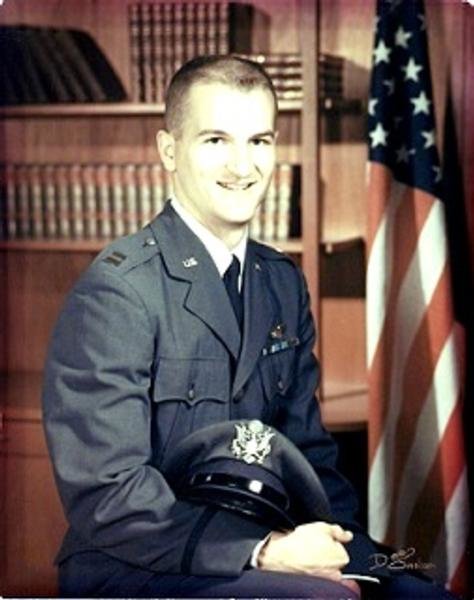This biography is excerpted from a written account by Capt. Duane Baker’s son, David. For the full video, interview click on this link.
Captain Duane S. Baker, United States Air Force, loved to fly. When he was four, his mom, “Lila” Marie Baker took him to an airshow. Fascinated, he asked, “what made it stay up.” From then on, all he ever wanted was to be a pilot. If he could connect it back to airplanes in school, he would, frustrating his teachers. One teacher assigned him a report about Native Americans, thinking this would give him a break from all the flying business. He found a Native American who was a pilot in WWII and wrote about the plane he flew.
He graduated from Oregon State with an A average in Aeronautical Engineering. He joined the Air Force and wanted to fly the F-100 Super Sabre, known to pilots as the “The Hun”. In pilot training, he worked hard and graduated third in his class behind two former Air Force navigators, and second in the gunnery school class at Luke AFB behind an experienced pilot who was transitioning to fighters.
I remember him as a calm, gentle man: my dad. This is how everyone describes him. Calm, gentle, and a good pilot.
From 1963-1966 Dad flew F-100s in Germany. First produced in 1953, the F-100 was capable of supersonic flight. It made extensive use of heat-resistant titanium and its fuselage was ultra-streamlined. It had a new device for aircraft, an afterburner. The pilot could touch a button on the throttle and dump fuel directly into the engine, giving a quick burst of power. Test pilot George Welch (later killed in an F-100 crash) described the effect of turning on the afterburner as being like “a kick from a well-fed mule.”
I learned much later that Dad’s primary job in Germany was to have a nuclear bomb loaded on to his F-100 in the event the Soviet Union invaded Western Europe. He and his squadron would have had to fly low toward a military base or line of tanks, pitch up at the last moment, release the bomb, make a hard turn and get away as fast as possible. The bomb would arc up, giving the pilot a few more seconds to escape, before hitting the ground and detonating. This was before guided missiles and must have appeared to be a desperation bombing attack with little chance of survival. A good reflection of the times.
Because of its design, approach speeds were much higher than with previous jets. F-100 pilots had to think faster and farther ahead. Because of its highly swept wings, the new fighter had vicious stalling characteristics. A pilot flying one of the early F-100s came in for an emergency landing when he began to stall. A film crew happened to be nearby and filmed the incident. The pilot kept trying to use the afterburner to pull out, but the plane kept stalling with the nose high in the air as it went down the runway. This became known as the “Sabre Dance”. The plane crashed and the pilot was killed. Review of the film was required of all F-100 pilots.
According to the book, “Boyd, The Fighter Pilot Who Changed the Art of War” by Robert Coram, chronicling the life of James Boyd- one of the Air Force’s top pilots- the F-100 was a lieutenant-killer, a widow-maker, a death-trap with a fearsome reputation. One-quarter of all the F-100s produced were lost in accidents. A forgiving aircraft tolerates mistakes by the pilot; it will not, as pilots say, “rise up and bite you in the ass.” The Hun was one of the most unforgiving airplanes ever built. It had to be flown every second; one wrong control move, one moment of inattention, and the F-100 would drop out of the sky. One pilot with 2,000 hours of experience described an F-100 landing as a controlled crash. From the time a pilot taxied out on the runway until he landed, the F-100 was trouble waiting to happen. The standard admonition for F-100 pilots at the end of a preflight briefing was “DBYA”— don’t bust your ass.
The plane was dangerous to fly in the best of conditions compared to passenger and cargo planes. But if you want to survive in an air battle, you have to go fast and turn hard. The pilots fully understood the dangers and tended to develop a false bravado of courage, recklessness and invincibility to deal with the fear, shown by their post-mission saying “we have challenged death once again.” All of this gave me insight into my dad, who wanted to fly a plane that seemed to be ridden more than flown.
Dad volunteered for Vietnam. In a letter to Mom (High School Classmate Lillian Hale), Dad talked about how hard it would have been for him to not go to Vietnam when others did. Dad arrived in Vietnam on Nov 24, 1966, assigned to the 416th Tactical Fighter Squadron at Bien Hoa. He believed in the war. He wrote Mom about what the North had done to people in the South and felt we would lose some of our own sense of morality if we did not help. Later, Dad was sent to help set up a new base for his squadron at Phu Cat. In addition to the administrative duties that were needed, he laid tile in the shower room because no one else knew how. In his letters, Dad talked about how much he wanted to get back to his daily flying missions.
In another letter to Mom, Dad wrote, “Sometimes I get afraid that I have been gone so long that I won’t know how to act. If I did not have your pictures and your letters and your love, honey, I would feel like I was lost. I’ll always love you and I’ll spend my whole life making you happy.” Obviously not the cold, detached, impersonal warrior characterization of military men portrayed by anti-war protestors.
I have a memory of going up to a mountain view when I was 3 or 4 years old. When I saw how high we were, I cried to go down. Dad carried me. At the bottom, I felt bad Dad did not get to see the view and told him he could go up if he wanted. Dad said no, he did not like being that high either and would rather stay down here with me. An interesting statement from a man who rode planes to 40,000 feet faster than the speed of sound.
In June 1967, two men in uniform came to the door and asked to speak to Mom. I was five years old. I closed the door and told Mom. A strained look came over her face. I went back to watching TV. I then heard Mom crying. When I went to look, Mom was sitting in a chair near the door with the two men talking to her. I did not understand or did not want to, and went back to the TV. I never asked Mom if this is how she found out. Over the years I decided I didn’t want to know.
Later Mom told my brother and me about Dad’s death and how we had to stay a family. I can clearly remember that I did not like what I was hearing and chose to not accept it. Mom received a letter from Colonel Ed Schneider, the Commanding Officer of Dad’s wing. The letter stated Dad was shot down by ground fire while strafing a suspected VC location west of the Marine Corps base at Chu Lai.
Life goes on. I went into the U.S. Marine Corps as an Infantry Officer. I would have been a pilot in the Air Force; maybe not so much to follow in Dad’s footsteps, but it sounded like a great job. But my eyes were not good enough, so I learned to sleep on the ground and eat out of a plastic bag in the infantry. I then went into the FBI as a Special Agent and became a bomb technician.
In April 2006, I was married with two young children living near Houston, Texas. Mom sent me a birthday present: the book Bury Us Upside Down, by Don Shepperd and Rick Newman, to help me understand Dad. The book is about the Vietnam unit, Commando Sabre, 416 TFS Detachment 1. Their nickname was “Misty”. The book chronicles a group of Air Force pilots using F-100s with two seats. The pilot would fly from the front seat and try not to get shot down. Another pilot would sit in the back and act as a Forward Air Controller (FAC) to spot targets on the ground and guide other planes to hit them. Apparently, Mom did not read the book before she sent it.
I recognized the 416th as Dad’s squadron, but Misty was a separate unit. I also recognized that they were stationed at Phu Cat, the same base Dad helped set up. As a history buff, I found the book interesting until I got to page 212. This chapter discussed Misty’s operations officer, Mick Greene, who stated he had been given his first in-country check ride from Captain Duane Baker. Greene stated that a few weeks later, Dad was strafing a suspected VC location west of the Marine Corps base at Chu Lai when the wings came off his airplane during the pullout from a bombing run. The plane dived straight into the ground, taking Dad with it. Greene and Colonel Lee, the Vice Wing Commander, were sent to the crash site to find out what happened. The flight surgeon recovered Dad’s body. The cockpit section of the airplane was in a shallow creek, the rest of the plane was elsewhere.
I was left staring at the book. At first, I believed Greene made a mistake. The book was written years after the war and maybe Greene confused Dad with someone else. They should not have lied to us about how he was killed. I sent an email to the publisher asking if they would forward it to Greene to clarify what happened.
A day or so later Greene kindly replied and confirmed what happened, but he did not know we had been told Dad was shot down. Greene stated; “As far as Colonel Schneider lying to you, I don’t think that was the case. He wasn’t anyone’s favorite person, but in his mind, a shootdown was probably more heroic and palatable to relatives than a structural failure. I don’t agree, for whatever that’s worth. Your dad was a skilled, respected, and well-liked fighter pilot.”
Don Shepperd, another Misty pilot and author of this book, also sent me an email. He told me he was in Germany with Dad, but in a different squadron. They flew together to train in Libya. Shepperd described Dad as a superb and well-respected pilot. An “old head.” Dad won many of their friendly bets at the gunnery range.
Mom and I decided it didn’t matter. Dad volunteered to go to war because his country called. Dad was firing on the enemy in support of U.S. troops on the ground when the wings pulled off his plane and it exploded. I would not have cared if he slipped in the shower, hit his head and died. He died a hero, serving his country.
The Misty pilots invited us to their yearly reunion. Shepperd said, “We are all here for you if we can help.” Though Dad was not in their unit, was not a close friend, and they did not know me or Mom, they were kind enough to treat us as if we were a part of their group. They did it out of respect and to honor a fellow soldier. They let me speak at their formal dinner. I told them this story and how the book had brought out many old feelings my family had buried. I thanked Lee and Greene for being on the team that went out to get my dad. I thanked Shepperd for writing the book that brought this out and told the group how much our family appreciated this happening.
These were military men, warriors. To be able to face the possibility of dying every day, it is necessary to embrace the concept and honor of dying in battle. Every culture has done this and it is not easy to describe to someone who has not fought in battle why it is necessary. Colonel Schneider and the others understood the dangers of war and the honor of serving. Nowhere is it written that to die an honorable death for your country you have to have been trying to kill or have someone trying to kill you. Maybe Colonel Schneider was afraid we would not understand. But we do. We are proud of Dad and hold no animosity toward anyone in the U.S. Air Force.
Leading up to the reunion, I did more research into the plane, and its many problems, failures, and deaths it caused. The F-100 was a workhorse. It flew more missions in Vietnam than any other aircraft. The F-100 was not designed as a bomber. The continued load placed on the wings caused metal bending which led to cracks near the wings. Greene’s analysis of Dad’s plane helped identify the problem on the F-100’s wings spars and that the same thing likely happened to other pilots. According to the book, “F-100 Super Sabre Units of the Vietnam War”, by Peter Davies, David Menard, Osprey Publishing, this metal fatigue could have also caused the structural failure and explosion of several other F-100s during this period making low-level attacks, including Major Len Niski in May 1967 and 1stLt James Cumiskey in June. According to other pilots, F-100 pilot Clyde Carter was returning from his last mission and started a high G rolling pull up when a wing came off, causing his fatal crash.
As we discussed this, Mom would forward the emails to her friends. Some of these discussions would get forwarded to the Misty group. After reviewing the problems and deaths caused by the F-100, in a fit of anger, I emailed Mom that the F-100 was a piece of crap. A longtime friend of Mom’s and an F-100 pilot who flew with Dad, Bob Sarchet, wrote back in an angry tone defending the F-100 and that I did not understand.
You don’t insult a craftsman’s tools. These men risked their lives flying this plane in peace and war. The plane accomplished what they asked it to do and brought them home. As happens between people working together in stressful situations, a relationship developed between the pilots and their planes; though maybe a dysfunctional one. One of the Misty pilots, Tom Tapman, who saw this exchange, emailed a quote from Ernest Hemingway and said this was how he felt about the F-100.
“You love a lot of things if you live around them. But there isn’t any woman and there isn’t any horse, not any before nor after, that is as lovely as a great airplane. And men who love them are faithful to them even though they leave them for others. Man has one virginity to lose in fighters, and if it is a lovely airplane he loses it to, there is where his heart will forever be.”
You also don’t insult a man’s first love. Later, Sarchet wrote “[Dad was] just a good pilot doing his job when the machine we all knew and trusted failed.” In these emails, I heard Dad yelling at me that the F-100 was a good plane.
Was it fair for me to call the F-100 crap? The F-100 was dangerous to fly, but Dad chose to fly it. James Boyd, who wrote the manual on air to air combat for the U.S. Air Force, loved it. Every F-100 pilot at the Misty reunion loved the plane. Everyone Dad flew with loved the F-100. In everything I have read about the F-100, none of the pilots bad mouthed it, but it killed Dad. The F-100 pioneered the design of operational supersonic aircraft.
A fighter has to fly fast and turn sharp, but this makes the plane inherently more difficult to fly. Same as a race car vs a family sedan. We were in the middle of the cold war and refused to except that we could lose. Dad was part of a team. The pilots that flew the F-100 and the mechanics that worked on them kept detailed records of the problems so they could be fixed and new aircraft improved. There was no cover-up. The Air Force and pilots knew the dangers and did their best to correct them, but they had a job to do. I hope pilots today know their wings are less likely to separate because my dad and others flew planes on which they did.
Every so often I realize I’m older than he ever was, this man I remember being strong, wise and grown-up. The F-100 taught me much about my dad; the man he was, what he believed in, how he felt. I’m sad the F-100 took him away from us so early. I have apologized to Dad for badmouthing the F-100.
David D. Baker












